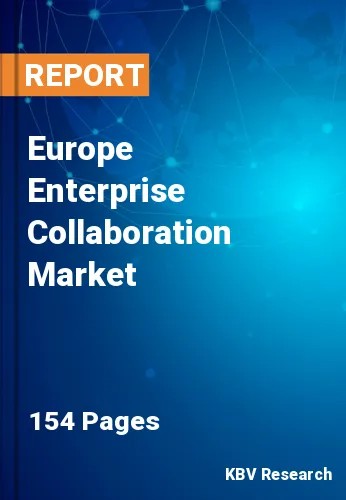The Europe Enterprise Collaboration Market would witness market growth of 11.6% CAGR during the forecast period (2022-2028).
By strengthening digital channels, enterprise collaboration solutions address business-critical requirements. They go beyond conventional solutions like business intranets to improve staff communication. Greater versatility in the way teams work improves business functionality. For example, a user can address a team huddle with enterprise collaboration solutions by conducting more informal and spontaneous meetings. Employees have more freedom to work and are not restricted by physical impediments. A scalable group channel is also available with an ECS. One-to-one or one-to-many communication is possible. This implies that every employee is well-informed, aware of their surroundings, and participates in task management. Moreover, the status of a project can be communicated immediately and easily. Enterprise collaboration technologies increase operational visibility and decision-making by centralizing all relevant resources and documents in one place and making updates simple to manage. Data points and analytics are accessible for businesses to monitor employee performance and provide assistance as needed.
The development of the regional healthcare infrastructure would positively impact the enterprise collaboration market in the region. According to the Office for National Statistics, in 2017, The United Kingdom spent £2,989 per person on healthcare. In addition, the healthcare spending in the country was 9.6% of the overall GDP of the country. The increasing investment by the government in the healthcare infrastructure of the country would unlock various new growth prospects for the enterprise market. Due to the increased funding, the healthcare facilities across the region would become capable of deploying enterprise collaboration solutions across their premises.
Due to the increasing government efforts, the utilization of enterprise collaboration tools would also increase in automotive manufacturing. Europe has one of the biggest automotive industries in the world.
The Germany market dominated the Europe Enterprise Collaboration Market by Country 2021, and would continue to be a dominant market till 2028; thereby, achieving a market value of $6.8 billion by 2028. The UK market is experiencing a CAGR of 10.7% during (2022 - 2028). Additionally, The France market would display a CAGR of 12.4% during (2022 - 2028).
Based on Component, the market is segmented into Solution and Services. Based on Solution Type, the market is segmented into Enterprise Video, Unified Messaging & Enterprise Social Network, Business Process Management, File Sharing & Synchronization, Project Management & Analytics, and Others. Based on End-User, the market is segmented into BFSI, Public Sector, Energy & Utilities, Manufacturing, Telecom & IT, Retail & Consumer Goods, Healthcare & Life Sciences, Travel & Hospitality, and Others. Based on Deployment Type, the market is segmented into On-premise and Cloud. Based on Organization Size, the market is segmented into Large Enterprises and Small & Medium Enterprises. Based on countries, the market is segmented into Germany, UK, France, Russia, Spain, Italy, and Rest of Europe.
Free Valuable Insights: The Global Enterprise Collaboration Market Size will Hit $107.1 Billion by 2028, at a CAGR of 15.6%
The market research report covers the analysis of key stake holders of the market. Key companies profiled in the report include IBM Corporation, Microsoft Corporation, Google LLC, SAP SE, Cisco Systems, Inc., Adobe, Inc., Facebook, Salesforce.com, Inc., Citrix Systems, Inc., and RingCentral, Inc.
By Component
By End User
By Deployment Type
By Organization Size
By Country
Our team of dedicated experts can provide you with attractive expansion opportunities for your business.

